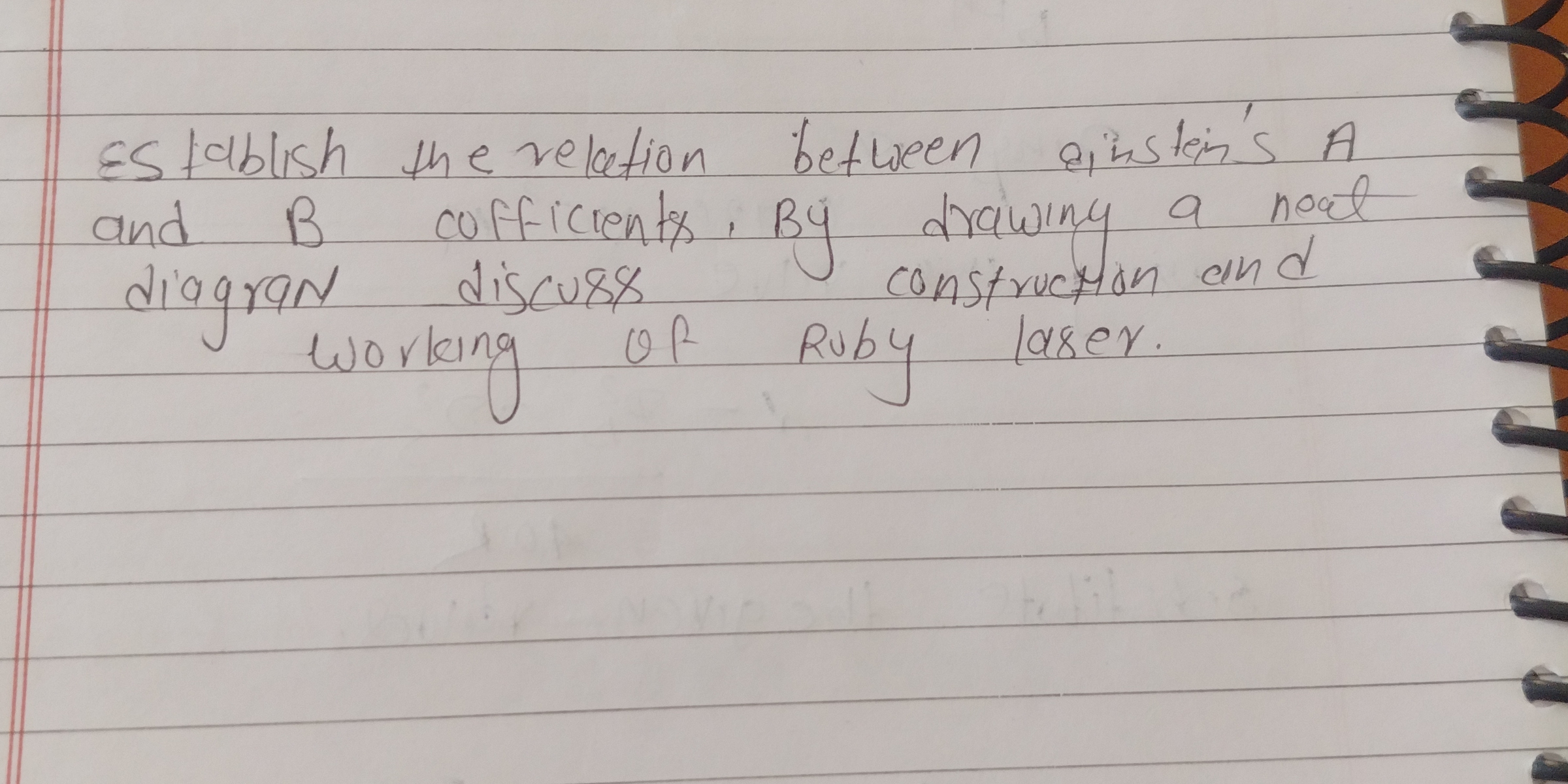Establish the relation between Einstein's A and B coefficients. By drawing a neat diagram, discuss the construction and working of a Ruby laser.

Understand the Problem
The question asks to establish the relationship between Einstein's A and B coefficients. Additionally, it requires a discussion of the construction and working principles of a Ruby laser, including a diagram.
Answer
Einstein coefficients relate probabilities of absorption, spontaneous emission, and stimulated emission. A Ruby laser uses a ruby crystal rod with mirrors. A flash lamp excites chromium ions in the rod, leading to stimulated emission and laser beam production.
The Einstein coefficients describe the probabilities of absorption, spontaneous emission, and stimulated emission of light by atoms or molecules. The relations between them are:
A21 = (8πhv³/c³)B21 B12 = B21
Where:
- A21 is the Einstein coefficient for spontaneous emission.
- B12 is the Einstein coefficient for absorption.
- B21 is the Einstein coefficient for stimulated emission.
- h is Planck's constant.
- ν is the frequency of the emitted light.
- c is the speed of light.
Ruby Laser Construction and Working
A Ruby laser consists of a ruby crystal rod, typically pink in color, surrounded by a flash lamp. The ruby crystal is made of aluminum oxide (Al2O3) doped with chromium ions (Cr3+). These chromium ions are the active medium responsible for laser action. The flash lamp provides intense light to excite the chromium ions to a higher energy level. Mirrors are placed at both ends of the ruby rod, one fully reflective and the other partially reflective, to form a resonant cavity.
When the flash lamp is turned on, it emits a burst of intense white light. The chromium ions in the ruby crystal absorb the green and blue wavelengths of the light, and are excited to a higher energy level. These excited ions quickly decay to a metastable state. When a photon encounters an excited chromium ion in the metastable state, it stimulates the ion to return to its ground state and emit a photon of the same wavelength, phase, and direction as the incident photon. This process is called stimulated emission. The photons are reflected back and forth between the mirrors, stimulating more and more chromium ions to emit photons. As the light passes through the ruby rod, it is amplified, and a portion of the intense, coherent red light is emitted through the partially reflective mirror as the laser beam.
Answer for screen readers
The Einstein coefficients describe the probabilities of absorption, spontaneous emission, and stimulated emission of light by atoms or molecules. The relations between them are:
A21 = (8πhv³/c³)B21 B12 = B21
Where:
- A21 is the Einstein coefficient for spontaneous emission.
- B12 is the Einstein coefficient for absorption.
- B21 is the Einstein coefficient for stimulated emission.
- h is Planck's constant.
- ν is the frequency of the emitted light.
- c is the speed of light.
Ruby Laser Construction and Working
A Ruby laser consists of a ruby crystal rod, typically pink in color, surrounded by a flash lamp. The ruby crystal is made of aluminum oxide (Al2O3) doped with chromium ions (Cr3+). These chromium ions are the active medium responsible for laser action. The flash lamp provides intense light to excite the chromium ions to a higher energy level. Mirrors are placed at both ends of the ruby rod, one fully reflective and the other partially reflective, to form a resonant cavity.
When the flash lamp is turned on, it emits a burst of intense white light. The chromium ions in the ruby crystal absorb the green and blue wavelengths of the light, and are excited to a higher energy level. These excited ions quickly decay to a metastable state. When a photon encounters an excited chromium ion in the metastable state, it stimulates the ion to return to its ground state and emit a photon of the same wavelength, phase, and direction as the incident photon. This process is called stimulated emission. The photons are reflected back and forth between the mirrors, stimulating more and more chromium ions to emit photons. As the light passes through the ruby rod, it is amplified, and a portion of the intense, coherent red light is emitted through the partially reflective mirror as the laser beam.
More Information
Einstein's coefficients are fundamental in understanding laser operation and light-matter interactions. The Ruby laser was the first successful laser, demonstrated by Theodore Maiman in 1960.
Tips
A common mistake is confusing the different Einstein coefficients. Remember A21 is for spontaneous emission, while B12 and B21 are for absorption and stimulated emission respectively.
Sources
AI-generated content may contain errors. Please verify critical information